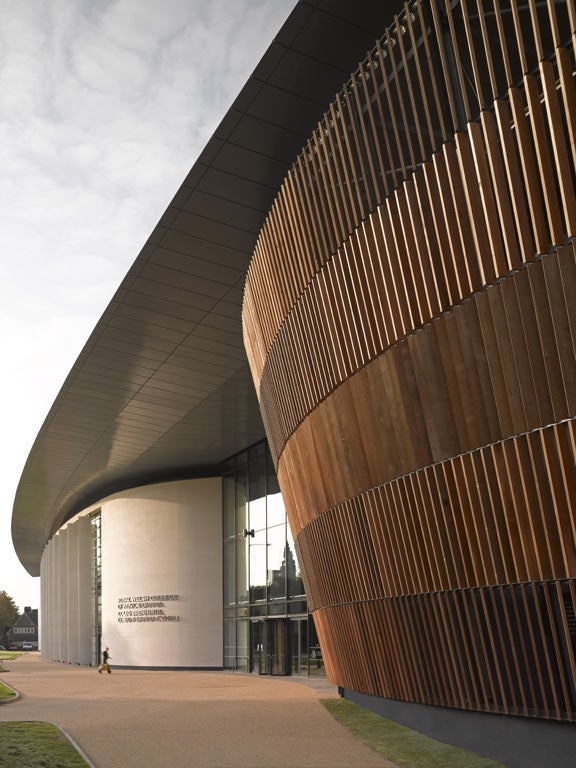Architecture that hits the high notes
A nondescript Cardiff building is reborn as virtuoso modernism

Until a few weeks ago, few people in Cardiff even knew where the Royal Welsh College of Music and Drama was.
It didn't help that this conservatoire was housed in a nondescript 1970s building on the eastern edge of the skinny canal that divides the college from Grade I listed Bute Park. Now, after a dazzling £22m extension, you couldn't miss the place if you tried.
A sharp-edged plastic roof oversails the college like the shimmering wing of a Jumbo jet, and the drum of its new concert hall suggests a vast, wooden-ribbed turbo-fan. Legendary Wagnerian soprano, Anne Evans, has just given a masterclass to students here. Comedian Rob Brydon is doing a turn this week .
It would be easy to dismiss the architecture as deliberately sensational and anti-contextual – just a bit of fun, as Brydon's catch-phrase has it. Just across North Road lie the civil limestone and concrete forms of the City Hall, Crown Court and University. How did the new building's lead designer, Jason Flanagan, come up with such a starkly contrasting form?
Short answer: he drew a super-crisp diagram which wrapped the ellipse of the new building around the northern and eastern edges of the existing college block: a cafe butted up against the end of the old building, a new free-standing segment containing the Burton theatre and practice rooms, and another housing the 450-seat Dora Stouzker recital hall. And the whole ensemble, including internal bridges and the "canyon" between the old building and the Burton theatre, covered by that giant aerofoil.
Flanagan and others at BFLS Architects previously worked for the king of the ultra-refined modernist diagram, Norman Foster. The college extension is a kit-of-parts in which the parts are specifically stand-offish. In Norm-land, it's not enough for form to have function; a building's different functional chunks must be quite distinct.
On a thin and difficult site, Flanagan has unquestionably turned his diagram into a building that performs, generating an atmosphere that can only be described as happening. It helped that he has a profound personal interest in music, acoustics and performance. Rather less predictable, from a practice that recently completed the controversial Stratus tower at London's Elephant and Castle, is the superbly crafted recital hall.
It's comparable in size to the mod-classical auditorium at King's Place, London. Here, the eye is teased away from the stage, towards a raised gallery of look-at-me columns. The college's recital hall is superior. Flanagan has encased its lower segment with coffered plywood walls that accentuate the auditorium's sloping lower volume, which rivets the gaze on the performers. There is a compelling sense of intensely concentrated performance. And the acoustic detailing, by Arup, produces a warmly articulated sound in the stalls which condenses into a drier precision in the gallery.
There's a similar atmosphere in the thoroughly luvvy-ish, purple painted Burton Theatre, though the glinting staves of silvery balcony rails jar. In a small theatrical space, why would actors want to see these when everything else is Stygian? Emlyn Williams' thriller, Darkness Falls, is the inaugural production. Let's hope it does fall.
The most significant aspect of the Coleg Brenhinol Cerdd a Drama Cymru is the big, two-storey high space between auditorium, theatre, and cafe. It is this void, with full height glazed facades facing both park and civic centre, that finally makes contextual and human sense of Jason Flanagan's virtuosic diagram. It has a great vibe, and outlook, an architectural machine that sings.
Join our commenting forum
Join thought-provoking conversations, follow other Independent readers and see their replies
Comments